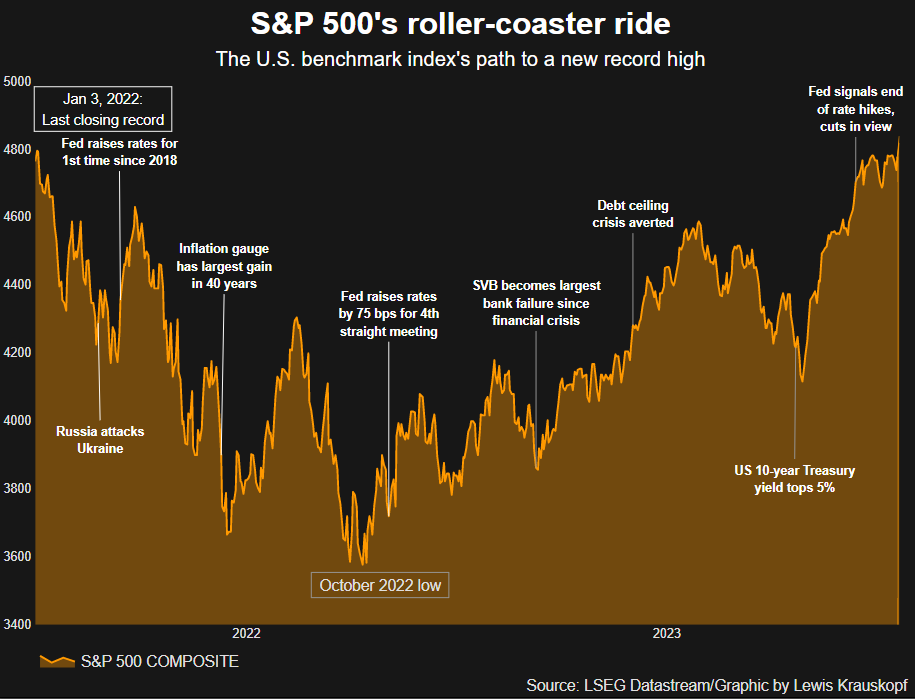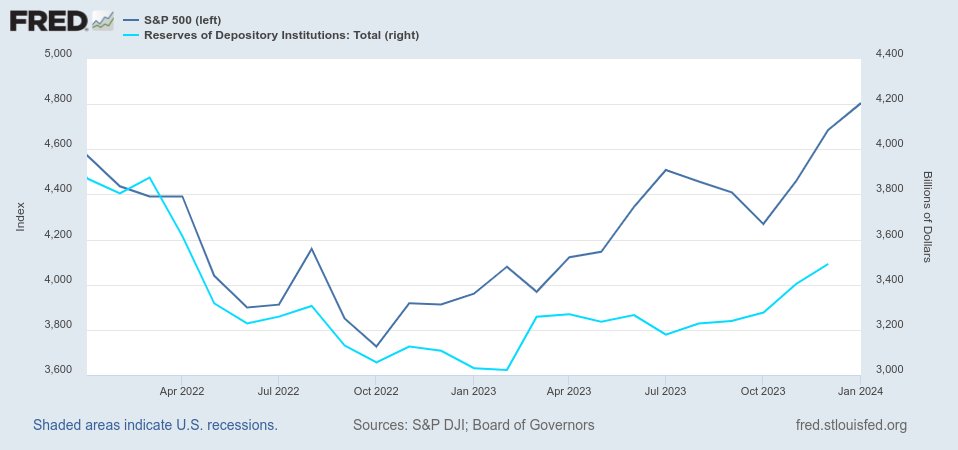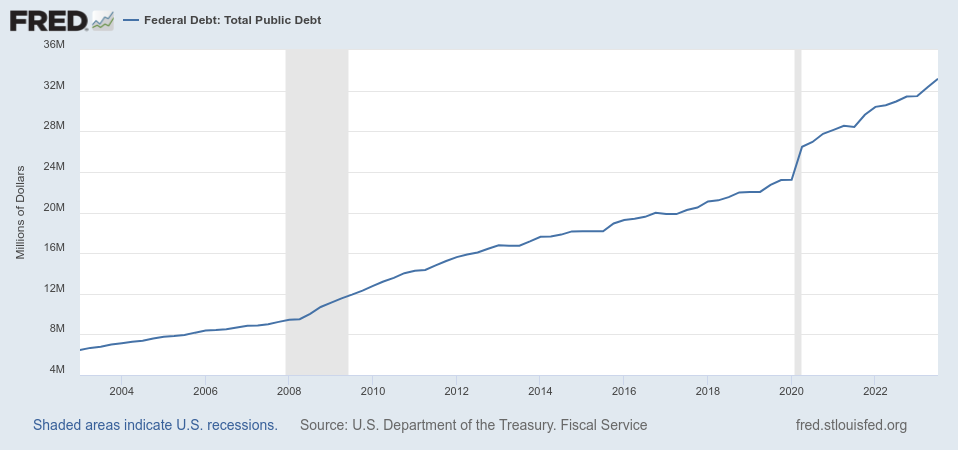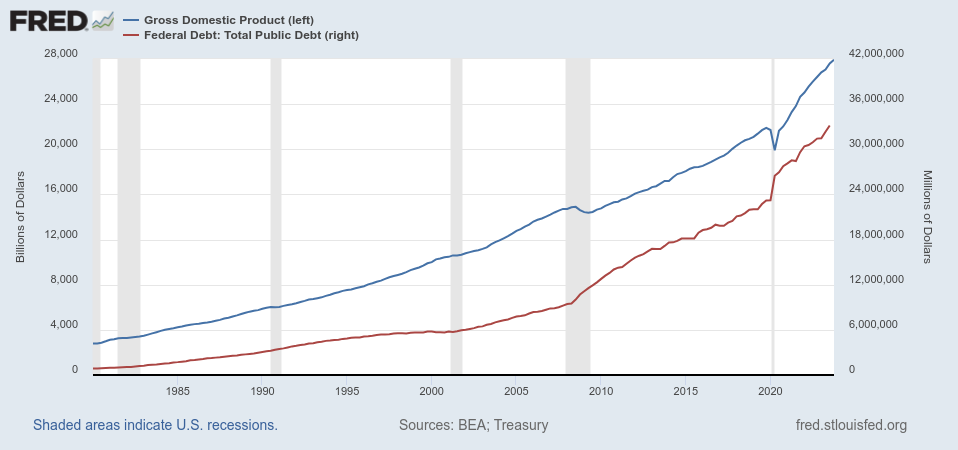The stock market is a powerful globally distributed forecasting system. Last Friday it was forecasting a rosy future as the MSCI World index got to a new all-time high. But it does not make sense.
There is no single entity controlling stock prices. They represent the collective best guess of the whole economic world on what the value of each company should be. Historically the market has been pretty accurate. For example, when the news broke about COVID-19 spreading, stocks plummeted in anticipation of a global crisis. And indeed, a pandemic followed that forced a large part of the economy to a standstill, and major government intervention was necessary to avoid total mayhem. As another example, in the first month of the Russian invasion of Ukraine in February-March 2022, the stock price of Cheniere Energy went up almost 50%, as the market predicted that this American liquified natural gas producer would hugely benefit from Russian competitors being blockaded. Again, the market was right – the by the end of 2022, Cheniere’s profits had doubled.
The MSCI World index has grown about 30% since the low point in the fall of 2022. The U.S. focused S&P index is even more extreme, having grown almost 40% since the low point in fall of 2022, ending last Friday at 4840, slightly above the previous closing high record 4797 set on Jan 3, 2022. Investors participating in the market are collectively forecast that the U.S. economy has recovered and things will be fine. There is just one problem. Everyone is wrong.
The U.S. market is looking way too good
The S&P will soon probably surpass 5000 points, but this party can’t last for long. Reuters has a great summary of economic events overlaid on the S&P 500 in past two years:

The situation seems very contradictory. Increased inflation should affect the purchasing power of consumers and companies negatively. While salary increases help consumers survive, and higher sales prices help companies offset increased costs, undeniably the overall effect is still negative. The U.S Consumer Price Index growth has slowed down a bit since the peak in 2022, but prices are still growing faster than in all of 2010’s. Due to inflation, the U.S. Federal Reserve increased in July 2023 its interest rate to 5.5%, and still keeps it there. High interest rates discourages companies from taking loans and making investments, so for the time being the economy should slow down, not accelerate.
Is the money printer is on again?
Following the insolvency of the Silicon Valley Bank on March 10th, 2023, the U.S. Federal Reserve announced it will guarantee the 200+ billion dollars the bank had lost. Soon it repeated it to a few more banks. Essentially the Fed printed 300+ billion dollars in March 2023. When you overlay the S&P 500 and the U.S Federal Reserve balance sheet the correlation seems pretty strong:

The upward trend in November and December might be related to U.S. lawmakers passing so-called “appropriation bills” to allow the U.S. government to continue overspending. Similar bills and resolutions are likely to repeat on March 1st and 8th, 2024. All of this makes me think the stock prices are out of touch with the underlying companies growth, and mostly just a function of how much money is being pumped into the U.S. economy by the government and the Fed.
This is not exactly anything new. Taking on more national debt seems to be the U.S. policy, no matter which president or party is on power:

What is new is the scale it has reached now. The sum is rapidly approaching 34 trillion U.S. dollars. That is 34 000 000 000 000 (12 zeros!). The sum is insanely large. Think about the most expensive single item one could buy: a USS Gerald R. Ford class nuclear powered aircraft carrier has a price tag of 12 000 000 000 (billion) dollars. The U.S. has 11 aircraft carriers and all other countries combined have 6–9, so in total under 20 in the world. With 34 trillion one could buy 2833 aircraft carriers á 12 billion.
The U.S. budget projections for 2024-2034 is a grim read. The deficit in 2024 is 1.6 trillion USD, and is forecasted to fluctuate between 1.6 and 2.6 trillion for the next 10 years. The interest payment for the national debt is 870 billion in 2024, and 951 billion in 2025 – the first year when U.S. debt interest payments exceeds the U.S. national defence budget!
Is this sustainable?
In 2024 the U.S. government is going to issue 1.6 trillion USD worth of completely new bonds. In addition, the U.S. government also needs to issue several trillion worth of new bonds in order to pay old lenders for bonds that mature in 2024. Somebody needs to buy this 5–10 trillion of U.S. bonds, and it is very unlikely the normal money markets would be able to absorb this supply. Thus, the Federal reserve bank system will need to step in and “print money” to buy up the bonds that don’t sell on the free market.
The USA is not alone in having a lot of debt. The national debt in Greece is around 150% of their GDP, and Japan has been at over 200% for a decade. However, the U.S. has a huge GDP, so having 120% debt-to-GDP ratio is exceptional in absolute numbers. Consider that when comparing national debt per capita, Japan and the U.S. both hover around 100k USD (depending on source), so actually the U.S. situation is already very worrying.
What is extra concerning is that for the past decades the GDP growth in the U.S. seems to correlate with their government overspending and taking on debt:

This begs the question: how much of the economic growth in the U.S. has actually been based on printing money to begin with? How much has there been improvement in real productivity? Due to how GDP is accounted, public debt automatically increases it, so some correlation is expected, but a very strong correlation as seen in the graph above could indicate that the real economy is not growing, only debt is. The stock market is supposed to grow over time as a function of the GDP and overall productivity growing, but is that really happening now?
One interesting observation when inspecting the S&P 500 and the MSCI world index constituents, is that they are both dominated by just seven large U.S. tech firms. However, their effect on U.S. GDP is limited, as their corporate profits are accounted in Ireland due to tax planning. This has led to the GDP of Ireland to skyrocket in the past 10 years from 50k to 100k USD per capita. If the U.S. government runs out of money, it will be much more likely to crack down on tax evasion practices and force the large tech companies to pay more corporate tax in the U.S. Seems like a major disruption factor to me. Yet their stock prices keep growing.
Expectations on the “magnificent seven”
The extremely high valuation is justified only if these seven companies are about to make a huge productivity leap that lifts the entire U.S. economy, including creating 1.7 trillion in additional tax revenue to close the deficit gap. Seems the stock market is predicting exactly that. Sure, artificial intelligence will help increase productivity everywhere, but I find it very hard to believe that AI productivity gains would accumulate on these tech companies to such a degree that their astronomical valuations would be justified. To me it seems that the market is now just plain wrong.
According to the World Federation of Exchanges (WFE) exchanges there are over 58 000 stock listed companies in the world. There should be plenty of options for the stock market to bet on. Yet the market predicts that the U.S. stocks in particular would be future winners.
My prediction for 2024 is a large correction across the U.S. stock market. If it does not happen already during the spring, surely latest after the U.S. presidential elections in November when keeping appearances ends and policymakers are ready to face the reality.
What is your read of the situation? Post in the comments below.